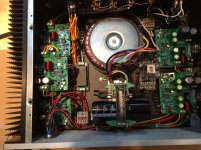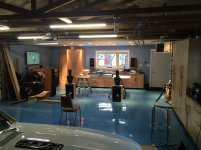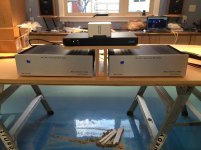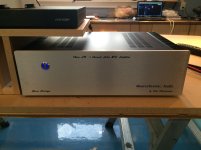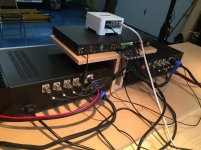Does the buzz go away when the laptop is running on battery power?
Tom
No, it's still present when the laptop is running on batteries .
Does the amplitude of the buzz vary in amplitude if you turn the volume up? You'll have to let go of the pot for the comparison as I'm sure it will buzz when you touch the (ungrounded) pot.
Have you you grounded the front metal surface of the volume pot yet?
I built a similar setup (except four channels and sans volume control and THAT Driver) for a friend who uses a Sonos. The MOD86 is driven by a miniDSP 4x2 and the miniDSP receives the signal from the Sonos. That thing is dead quiet on both channels. I'm rather puzzled why you're having such trouble.
Tom
Have you you grounded the front metal surface of the volume pot yet?
I built a similar setup (except four channels and sans volume control and THAT Driver) for a friend who uses a Sonos. The MOD86 is driven by a miniDSP 4x2 and the miniDSP receives the signal from the Sonos. That thing is dead quiet on both channels. I'm rather puzzled why you're having such trouble.
Tom
No. Actually the Modulus-86 is about 27-28 dB better than the Akitika based on the measurements shown for THD at 40 W (Modulus-86) and 53 W (Akitika).
Note that the graph for the Akitika is relative to 53 W, i.e. 0 dB on the graph is the voltage of the fundamental. The Modulus-86 measurement is in dBV. I.e. 0 dB on the graph is 1 V RMS. Thus, to compare the two graphs, subtract 25 dB from my measurement.
The result is:
Akitika THD: -97 dB (0.0014 %)
Modulus-86 THD: -124 dB (0.000061 %)
Tom
Thanks for the clarification Tom and apologies for my sloppy comparison! I was taking your headline figure of <0.0004 and (wrongly) comparing it to the 0.0014% Akitika figure.
No worries. I took it as a suggestion to present my data with the vertical scale normalized to the fundamental power. That's probably the best way to present the data as that makes it possible to read the THD directly from the plot.
Tom
Tom
Ed's Obsession
Hi Fellas,
Thought I would share with you my project. I am an EE but zero experience building audio stuff. Always been interested in hifi though since I bought my first system in'78 (Harbeth + Quad 405 ... still have those). So the speakers I was using in my newly built shop had a buzz so I poked around looking for speakers to build. I helped a buddy build a set of KEFs in '76 and they were crap. I had no idea that a person could actually build a good set of speakers today from a kit, but from the various sites and reviews - wow - it sounded like there was some very high quality stuff out there.
So I gravitated to Madison Audio. I built a set of Zaph ZA 5.2s for the deck on my cabin. With a subwoofer - man - those things rock. Then I built a set of SEAS Idunn's for my shop. Those also rock.
My curiosity continued and I saw these bizarre Linkwitz things - the LX Minis. So after spending a lot of time on his site and poking around I decided to build a set of those. I found a used NAD T773 7 x 100W amp for cheap and managed to get it to work with the LX Minis that require 4 channels. Wow - blows my mind how those things sound - just incredible sound from such an odd looking package. My wife even likes them.
So my curiosity continued to build. On the Linkwitz OPLUG forum there is a seeking auditions section - turns out a fellow had a set of LX521's and he lived nearby me. Turned out to be OldMike2 from Canada. So I went to his house. He's got the most unbelievable man-cave home cinema. Better than the Odeon. I don't want to tell you all the stuff Mike has there but holy cow it is impressive. Was it 17 monoblocks Mike? He built all of it too.
So guess who was there the same day ... Tomchr. Ya. So the three of us talked for a while and in the end I decided to build some LX521's and ... some custom amps using Tom's Modulus 86's and Par 86's. Never soldered a thing in my life but how hard could it be?
For now my source is Sonos only. It runs through a MiniDSP 4 x 10HD into the amps. The amps are 5 channels apiece. Each amp has three Modulus 86's for the upper LX521 baffles and two Parallel 86's for the woofers. I also used Tom's Pwr 86's for the power supplies. Tom and Mike recommended the chassis from Modushop in Italy - so I bought those too.
The front faceplate on the amp chassis is 1cm brushed aluminum - just plain. I found this place where you can design your front panel and they mill it - frontpanelexpress.com in Seattle. I designed the front panel using their software then shipped the panels to them, then they shipped them back. Turned out real nice. It was about $150US total. You will see from the front panels that I wanted to give Tom some credit for his incredible designs so with his permission I put his name there along with Neurochrome :: Audio. He seemed to like it.
I used balanced XLR connections from the MiniDSP to the amps. I also used Speakon connectors. Very happy I did so. Nothing like good connectors. The balanced connections probably helped achieve a very low sound floor. The system is dead quiet at idle with no hums.
Tom and Mike came over for an audition - and I think they liked. Really, the sound is incredible even with the concrete floor in my shop. The amps are pure, clean and effortless.
By the way, Tom is a half decent goalie too. I had him out a couple times for a senior's hockey team that I run.
Thanks again to Tom and Mike for the inspiration. OK here's the pics.
Hi Fellas,
Thought I would share with you my project. I am an EE but zero experience building audio stuff. Always been interested in hifi though since I bought my first system in'78 (Harbeth + Quad 405 ... still have those). So the speakers I was using in my newly built shop had a buzz so I poked around looking for speakers to build. I helped a buddy build a set of KEFs in '76 and they were crap. I had no idea that a person could actually build a good set of speakers today from a kit, but from the various sites and reviews - wow - it sounded like there was some very high quality stuff out there.
So I gravitated to Madison Audio. I built a set of Zaph ZA 5.2s for the deck on my cabin. With a subwoofer - man - those things rock. Then I built a set of SEAS Idunn's for my shop. Those also rock.
My curiosity continued and I saw these bizarre Linkwitz things - the LX Minis. So after spending a lot of time on his site and poking around I decided to build a set of those. I found a used NAD T773 7 x 100W amp for cheap and managed to get it to work with the LX Minis that require 4 channels. Wow - blows my mind how those things sound - just incredible sound from such an odd looking package. My wife even likes them.
So my curiosity continued to build. On the Linkwitz OPLUG forum there is a seeking auditions section - turns out a fellow had a set of LX521's and he lived nearby me. Turned out to be OldMike2 from Canada. So I went to his house. He's got the most unbelievable man-cave home cinema. Better than the Odeon. I don't want to tell you all the stuff Mike has there but holy cow it is impressive. Was it 17 monoblocks Mike? He built all of it too.
So guess who was there the same day ... Tomchr. Ya. So the three of us talked for a while and in the end I decided to build some LX521's and ... some custom amps using Tom's Modulus 86's and Par 86's. Never soldered a thing in my life but how hard could it be?
For now my source is Sonos only. It runs through a MiniDSP 4 x 10HD into the amps. The amps are 5 channels apiece. Each amp has three Modulus 86's for the upper LX521 baffles and two Parallel 86's for the woofers. I also used Tom's Pwr 86's for the power supplies. Tom and Mike recommended the chassis from Modushop in Italy - so I bought those too.
The front faceplate on the amp chassis is 1cm brushed aluminum - just plain. I found this place where you can design your front panel and they mill it - frontpanelexpress.com in Seattle. I designed the front panel using their software then shipped the panels to them, then they shipped them back. Turned out real nice. It was about $150US total. You will see from the front panels that I wanted to give Tom some credit for his incredible designs so with his permission I put his name there along with Neurochrome :: Audio. He seemed to like it.
I used balanced XLR connections from the MiniDSP to the amps. I also used Speakon connectors. Very happy I did so. Nothing like good connectors. The balanced connections probably helped achieve a very low sound floor. The system is dead quiet at idle with no hums.
Tom and Mike came over for an audition - and I think they liked. Really, the sound is incredible even with the concrete floor in my shop. The amps are pure, clean and effortless.
By the way, Tom is a half decent goalie too. I had him out a couple times for a senior's hockey team that I run.
Thanks again to Tom and Mike for the inspiration. OK here's the pics.
Attachments
Thanks for posting, Ed. Nice build! I really like how those front panels came out. Thanks for the credit.
Your attention to detail really shows in the soldering you did on the board. Everything came out nice and clean. I hope those who are doubting their skills take note. 🙂
The Modulus-86/Parallel-86 combo driving the LX521.4 was amazing - even in the garage. I'm glad you got in on the last group buy of the Parallel-86.
Tom
Your attention to detail really shows in the soldering you did on the board. Everything came out nice and clean. I hope those who are doubting their skills take note. 🙂
The Modulus-86/Parallel-86 combo driving the LX521.4 was amazing - even in the garage. I'm glad you got in on the last group buy of the Parallel-86.
Tom
Too bad Siegfried wasn't there to listen as well - I'm sure he'll endorse Neurochrome like he has with Hypex & ATI.
Great work with the build & enjoy!
Best,
Anand.
Great work with the build & enjoy!
Best,
Anand.
The Modulus-86/Parallel-86 combo driving Orion speakers are also a compelling listen. I built four custom oak versions of the Orion 3.5 for my local 12th Century church. Sited correctly I cannot stress how good they are as a organ speaker. They breathe and fill large spaces so well. Choral music comes alive with the rear radiation into the chancel. The amps are extremely good at delivering vocals.
For playback we use my old Meridian 598DP/ 568.2MM combo. The organ is catered for by a Mac Mini and Hauptwerk.
As part of our December concert series we are showing on the big screen St John Passion - Bach Collegium Japan.
Stunning. Thanks Tom.
P.S. I need to order some more soon!
For playback we use my old Meridian 598DP/ 568.2MM combo. The organ is catered for by a Mac Mini and Hauptwerk.
As part of our December concert series we are showing on the big screen St John Passion - Bach Collegium Japan.
Stunning. Thanks Tom.
P.S. I need to order some more soon!
Last edited:
Great job Ed,
As Tom said anyone having doubts about their ability to build the Mod 86 take note from Tom's comments and Ed's build.
As a Linkwitz LX521.4 owner, and fan, I'm biased, but the sound was fantastic.
17 monoblocks plus 6 channels of an ATI 2007 in service. 15 channels for my 3 LX521.4's, 4 channels for surrounds and 4 channels for BFM horn subs.
Now I need to upgrade my amps. Are you reading Tom? No pressure, I just need those 200 watt units!!!! Exceptional as the Mod 86 is it just doesn't have the oomph for my subs and movie watching.
As Tom said anyone having doubts about their ability to build the Mod 86 take note from Tom's comments and Ed's build.
As a Linkwitz LX521.4 owner, and fan, I'm biased, but the sound was fantastic.
17 monoblocks plus 6 channels of an ATI 2007 in service. 15 channels for my 3 LX521.4's, 4 channels for surrounds and 4 channels for BFM horn subs.
Now I need to upgrade my amps. Are you reading Tom? No pressure, I just need those 200 watt units!!!! Exceptional as the Mod 86 is it just doesn't have the oomph for my subs and movie watching.
Oh, I'm reading! 🙂 I've told several folks that I'll have the 200 W design ready this coming spring. I'm making good progress on clearing the road blocks that are in the way, so it's looking up.
200 W is the stretch goal. 150 W committed. I'm sure I can make 200 W happen in the simulator. The question is how much reality and physics will agree with me. The power dissipation in a 200 W class AB amp is not for the faint of heart. I will be wearing safety glasses during the initial testing!
BTW: If you are interested in getting a bit of advanced notice of future products, I suggest subscribing to my newsletter: Sign Up to Stay Informed
I'll send one out a few times a year (no more than 2-3/year). That's easier than trying to address the "what's next" questions here.
Tom
200 W is the stretch goal. 150 W committed. I'm sure I can make 200 W happen in the simulator. The question is how much reality and physics will agree with me. The power dissipation in a 200 W class AB amp is not for the faint of heart. I will be wearing safety glasses during the initial testing!
BTW: If you are interested in getting a bit of advanced notice of future products, I suggest subscribing to my newsletter: Sign Up to Stay Informed
I'll send one out a few times a year (no more than 2-3/year). That's easier than trying to address the "what's next" questions here.
Tom
There's a price to pay for succeeding. It sounds like the nonstop teakettle whistle of tinnitus. That power level is not recommended for home use. You're on the fast track for that; but, is it needed? I do not know if that is needed. That way, you can find out when you have enough power. But, unfortunately, that's when you also find out not to use a concert power amplifier indoors.Oh, I'm reading! 🙂 I've told several folks that I'll have the 200 W design ready this coming spring. I'm making good progress on clearing the road blocks that are in the way, so it's looking up.
200 W is the stretch goal. 150 W committed. I'm sure I can make 200 W happen in the simulator. The question is how much reality and physics will agree with me. The power dissipation in a 200 W class AB amp is not for the faint of heart. I will be wearing safety glasses during the initial testing!
Tom
Before considering incurring such a long lasting annoyance, I suggest that one may want to consider that the audio amplifier power output wasn't the lack.
Unfortunately, it is sure that this comment will fall on deaf ears.
WHAT!!!?? I can't hear you over my tinnitus! Louder! Louder! 🙂
As OldMike pointed out, there are applications where you actually need the power. Some folks have large home theatres or large listening spaces. I do agree that in most cases, people want the power but don't need the power. Marketeers have done a wonderful job at convincing the general public that they need at least 100 W per channel, preferable more. No amount of math will convince them otherwise. Marketing is sexy. Math is not sexy. That's how the world works.
There is customer demand for a high-power solution. A 150-200 W design will be about right and will fill that need. In OldMike's case there's also the little detail of having a stockpile of super nice 1 kVA Plitron power transformers in power supplies generating ±60 to ±70 V that he'd like to reuse.
I was about to design an amp around the LME49810/811 when TI discontinued them. Grr!! So now I'm cooking my own solution.
Tom
As OldMike pointed out, there are applications where you actually need the power. Some folks have large home theatres or large listening spaces. I do agree that in most cases, people want the power but don't need the power. Marketeers have done a wonderful job at convincing the general public that they need at least 100 W per channel, preferable more. No amount of math will convince them otherwise. Marketing is sexy. Math is not sexy. That's how the world works.
There is customer demand for a high-power solution. A 150-200 W design will be about right and will fill that need. In OldMike's case there's also the little detail of having a stockpile of super nice 1 kVA Plitron power transformers in power supplies generating ±60 to ±70 V that he'd like to reuse.
I was about to design an amp around the LME49810/811 when TI discontinued them. Grr!! So now I'm cooking my own solution.
Tom
Some of them were brought back, though. The LME49710, for example. Sadly not the LME49810/11/30. That's understandable, though. High power is class D these days, except for those of us crazy enough to fight the thermals of a Class AB design. The chips probably weren't selling. They were also in packages that weren't used by other products.
Tom
Tom
I'm not sure it's all due to class-D. Those integrated input stages weren't as useful as complete chipamps are. For any company able to design a high power class AB amp, the input and driver stage is a small part of the design in terms of costs and space.
There is certainly no lack of high power AB projects in the solid state forum. Heck, the forum is pushing a 150W/8r project on newbies with the honey badger.
There is certainly no lack of high power AB projects in the solid state forum. Heck, the forum is pushing a 150W/8r project on newbies with the honey badger.
The power question is a two-edged sword. On one hand, most people don't need the power they think they need. On the other hand, there is research that shows that much perceived amplifier 'sound' is due to varying overload performance when driven too hard. The only way I can reconcile those two is to conclude that much audiophile listening is done at sound levels that are too high. I know that many rooms at audio shows like RMAF are painful.
I think I power have an advantage if they are well done, low distortion figures at high power definitely benefit audio playback. But as you get into higher power, you also get the drivers into the nonlinear region more often, thus you need to linearise large signal driver performance as a total system.
There is certainly no lack of high power AB projects in the solid state forum. Heck, the forum is pushing a 150W/8r project on newbies with the honey badger.
The trick is to deliver high power with Modulus-86 level performance. Few can do that.
Tom
- Home
- Amplifiers
- Chip Amps
- Modulus-86 build thread
